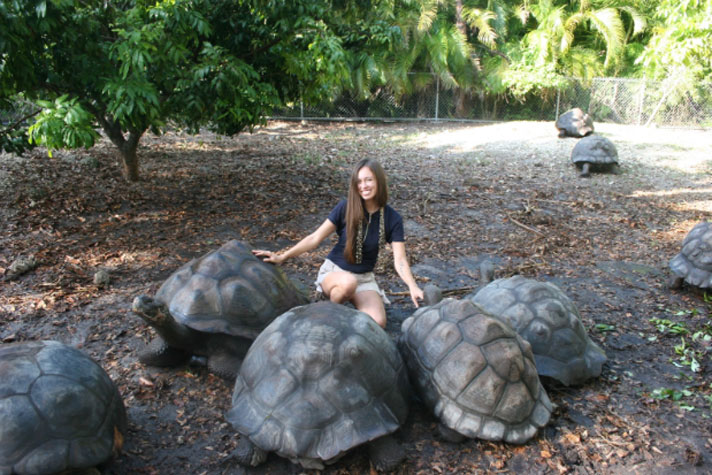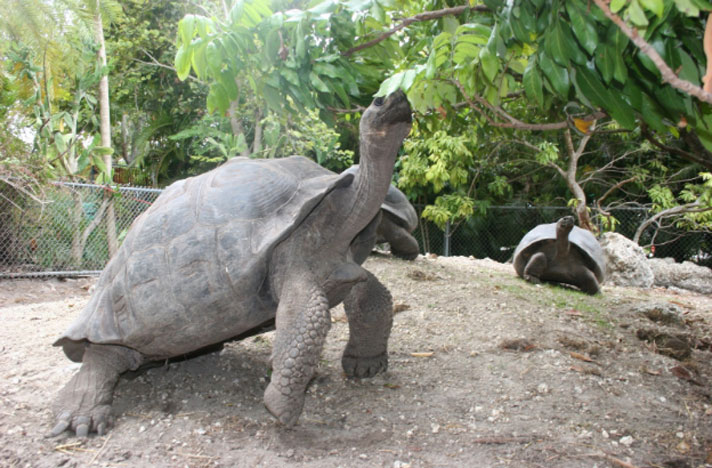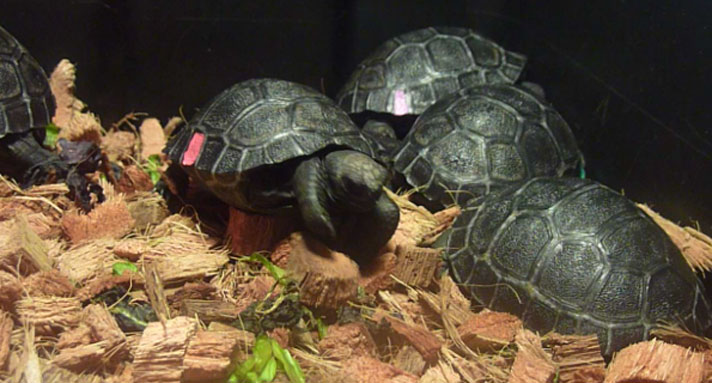Tortoises at Three Jays Tortoise Sanctuary include both hybridized and pure sub species of the Galapagos tortoise, including G.e. guntheri and C. Porteri.
Private conservation facilities have always been important contributors to species survival plans. Few private facilities are recognized for their efforts. Three Jays Tortoise Sanctuary, a FWC and USDA licensed and insured private (and possibly the largest) Galapagos tortoise captive breeding facility in the United States, is one of the few recognized for its reptile conservation contributions toward helping the critically endangered Galapagos tortoise, Geochelone nigra.

Rebekah Pettit
ReptilesMagazine.com contributor Rebekah Pettit volunteers at the Three Jays Galapagos Tortoise Sanctuary in Florida.
At any moment, natural disaster, invasive species or disease, or other events could wipe out an entire island, making critically endangered island species even more susceptible to extinction. Three Jays emphasizes and represents the importance of captive assurance colonies, especially for island dwelling creatures.
Owned by the “Three Jays,” three private, tortoise loving folks felt the need to help conserve and protect this special species. When “Life Fellowship Bird Sanctuary” was rehoming its group of giant tortoises, they knew what they were called to do. To date, more than 100 healthy hatchlings have been produced by the facility, led by head curator, Jason Abels. Being fortunate enough as a facility affiliate, volunteer and intern, it became quickly obvious that pristine husbandry, enrichment, and a naturalistic experience are the goals at Three Jays, and every hatchling born is a giant step for the survival of the species.

Rebekah Pettit
The tortoises at Three Jays roam freely and commingle with other tortoises.
Tortoises at Three Jays Tortoise Sanctuary include both hybridized and pure sub species of the Galapagos tortoise, including G.e. guntheri and C. Porteri. Usually, in any conservation program, hybridization is a great threat, but with these giant tortoises there is a remarkable exception, since hybridized DNA can help bring an extinct subspecies back over time, thanks to selective breeding programs.
All of the tortoises at the facility commingle on the property, enjoying mud baths, human interaction, daily enrichment, and a generous amount of herbivorous treats and hay. Although not open to the general public, Three Jays has touched the hearts of many, representing the importance of captive assurance colonies through private encounters, event donations, and raising awareness through social media and conservation events.

Rebekah Pettit
Galapagos tortoise hatchlings at the Three Jays Tortoise Sanctuary.
Regular health checkups, constant observance, record keeping, quality husbandry and incubation standards are all part of the ongoing responsibilities carried out by the sanctuary. When a female is finally nesting, head curator Jason Abels will observe her behaviors for days to weeks. When she finally decides to lay her eggs, Abels will hand-catch every clutch, document the details, and artificially incubate them. After four to eight months, mini critically endangered giants hatch. They are then raised for a short period of time to ensure their health and then are sometimes donated or sold lawfully throughout the pet trade and captive programs. They are not released onto the Galapagos Islands.
Along with these hatchling contributions, Three Jays Tortoise Sanctuary participates in breeding loans with other reptile conservation programs as well as research studies including genetic analysis and captive chelonian health research. They are participants of the AZA Species Survival Plan for the Galapagos tortoise, a program “designed to ensure the survival of selected species in zoos and aquariums, most of which are threatened or endangered in the wild.”
Not too many private facilities are accepted to participate in this program compared to corporate zoos and facilities. It is important to note that every critically endangered species born in captivity is a giant step for species conservation, regardless of their intentions to be sold as a pet or not. Neither should ever be considered “wrong” when done legitimately because both increase the number of critically endangered species back onto the planet.
Three Jays Tortoise Sanctuary and its successes depict a need for private captive conservation programs. All of the tortoises here are loved, cared for, and a long living example of why captivity is a positive for critically endangered species.



